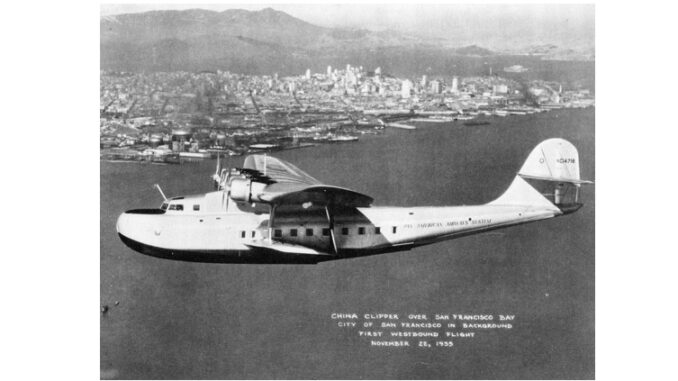
Prior to the Second World War, paved aircraft runways were few and far between. They didn’t exist at all in undeveloped countries, a fact that made international air travel almost impossible. Pan American World Airways, better known simply as Pan Am, made overseas air travel possible even to the most inhospitable of destinations with a series of flying boats beginning in the mid-1930s. This strategy was successful, as it allowed the airline to provide service to destinations around the world, as long as there was a body of water nearby. Pan Am started regular flights with ten Sikorsky S-40 “Clippers” in mid-1935, replacing them with three much more capable Martin M-130s in late 1935 to early 1936. Pan Am named the new flying boats, China Clipper, Philippine Clipper, and Hawaii Clipper. The moniker of “Clipper” served as an homage to the Yankee Clipper tall sailing ships of the nineteenth century, famed for the speed with which they crossed oceans.
The first Martin M-130, China Clipper, departed San Francisco on November 22, 1935, bound for Manila with intermediate rest and refueling stops at Honolulu, Midway Atoll, Wake Island, and Guam. Regular weekly flights commenced in October 1936. Able to carry 36 passengers on day flights, or 18 on overnight sleeper flights, Clippers were big, sophisticated, and luxurious by the standards of the time, but out-of-reach expensive for average folks.
In July, 1938, Hawaii Clipper began another routine trip out of San Francisco. On board were six passengers and nine crew members (Captain, First Officer, Junior Flight Officer, Engineering Officer, Assistant Engineering Officer, Radio Operator, Navigation Officer, and cabin stewards). No doubt the airliner also carried a good deal of airmail under government contract, a profitable business for airlines in the thirties. Overnight stops at Honolulu, Midway Atoll, Wake Island, and Guam proceeded as scheduled. The Hawaii Clipper took off for Manila on July 28, never to be seen again. A search commenced almost immediately after the aircraft was to have arrived. No debris was ever found, but an oil slick was. Samples of the oil were analyzed, which investigators concluded did not match petroleum products the Martin M-130 used. (Modern investigators question the techniques and results of the time, however.)
Naturally, a number of conspiracy theories have grown out of the Clipper’s unexplained disappearance. One or two of them have captured the attention of Guy Noffsinger, a former US Navy intelligence officer (among other occupations). Noffsinger has spent much of the last two decades researching the disappearance, interviewing anyone he could find – usually family members of the missing – and making several trips to the region where the plane last made radio contact. The theory that Noffsinger and a team of nine others are trying to prove involves… Amelia Earhart. Yes, of course, it all makes sense now! It seems that the Hawaii Clipper was carrying a $3 million ransom to pay off renegade Imperial Japanese Navy (IJN) officers who had captured Earhart in 1937. Sadly, the IJN officers lied about holding Earhart prisoner. What the treacherous IJN really wanted was the Martin M-130 in order to study it, especially its engines which were… really not all that extraordinary or cutting edge at the time. But! The IJN thought they were worth hijacking the plane for, so they had two agents disguised as mechanics smuggle themselves aboard the plane the night before it left Guam. The agents hijacked the plane (with samurai swords, no doubt) and forced the pilots to take them to Truk atoll. To cover their tracks, the IJN officers murdered the fifteen crew and passengers and encased them in concrete as the foundation was poured for an IJN medical dispensary on Tonowas Island. The Martin M-130 Hawaii Clipper was flown in secret to Japan where it was disassembled and all its technological secrets revealed.
On Noffsinger’s fourth trip to the region, he and his team located the foundation of the wartime dispensary, which had been bulldozed after a recent typhoon destroyed the building. The searched with ground penetrating radar and other techniques, without finding evidence of any bodies. Luckily, on their last day on the island before they had to leave, they found a vintage tie pin and buttons that could have come off of 1930s Pan Am uniforms.
Shortly after they returned home, COVID-19 wrecked their plans to go back ASAP. Two years have now passed, but Noffsinger is hopeful the pandemic will be over soon, allowing the team to get back there and blow the lid off this mystery.
What d’ya think about that?
